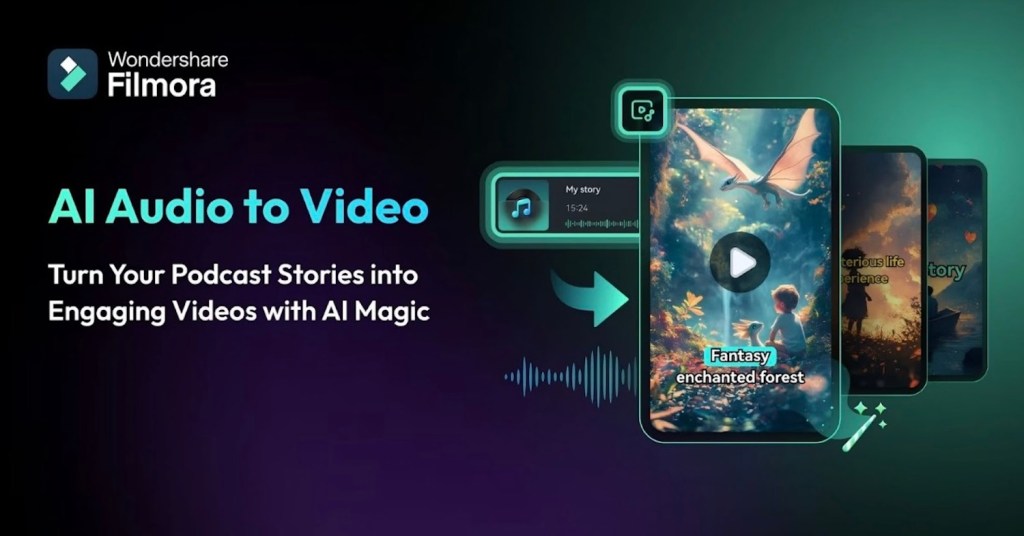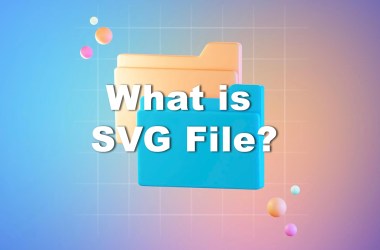Updated: Mar 03, 2025 By: Marios

In today’s world, the way we consume information has evolved drastically. The rise of YouTube and other video platforms has significantly changed the landscape of content creation. Now video is the main way for storytelling, and also history videos. Whether it's old times or important events now, showing history stuff with cool visuals can really make people pay attention and see it more.
Traditional video production demands substantial editing and animation expertise because it usually consumes enormous amounts of time. Artificial Intelligence (AI) provides the mechanism required in this application. The integration of Artificial Intelligence tools enables first-time creators to make professional content regardless of their lack of video editing mastery.
One such AI-powered tool is Filmora AI Audio to Video feature which allows creators to easily transform their audio content into visually dynamic videos. Creator users benefit from this innovative technology since it enables them to generate impactful visual content from their audio material.
The combination of audio narration with AI-generated visuals creates a solution that automates video development for history content creation.
Step 1: Gathering Your Audio Content
The following best strategies for obtaining audio content will enable your history videos to progress smoothly from the introduction segment.
Audio quality forms the essential basis for any fascinating historical narrative. Start by establishing the perfect audio quality before moving to Filmora AI.
Researching compelling historical events and drafting your script:
The selection of an audience-relevant historical topic stands as your first vital step when making a history video. Every history video requires a narrative which connects emotionally with audience members Whether it’s World War II, the Egyptian pyramids, or the life of a historical figure. While the topic is important, it’s the way you tell the story that truly matters. Your audience will love stories that strike a chord with them. Look for hidden details or fresh viewpoints on documented events.
To create a compelling script:
- Dig deeper: Obtain obscure facts alongside fresh analytical approaches toward already documented occurrences. Your video gains better value and interest through unique perspectives.
- Structure your script: A well-structured script is essential for maintaining a logical flow. Organize the content chronologically, highlighting key moments, figures, and events that shaped history.
- Use authentic materials: Blend original source materials into your video by adding historical letters speeches pictures and articles from the past. These add authenticity and depth to the narrative.
Recording high-quality audio narratives: Pick a quiet spot away from noise and echo. A good mic should sit 6-8 inches from your mouth. WAV format will give you the best audio quality. Your volume should stay steady throughout the recording.
Tips for making your audio engaging: The manner in which you deliver your content determines how people understand historical content. This guide contains all necessary information for your understanding.
- Tone: Match your voice to the story you're telling by Speaking respectfully about serious historical moments. Show excitement when talking about discoveries. Stay professional with controversial subjects
- Pace: The length of your phrasing should be adjusted through both slow delivery for detailed segments and faster delivery for other parts to maintain audience interest. Pick up speed during action. Add short pauses after key points
- Clarity: Deliver your information effectively through precise pronunciation of all historical terminology. Experts should transform complicated information into several simpler pieces. Connect different historical events smoothly.
Before loading audio into Filmora you need to listen to hard sections multiple times and fix all errors to ensure high-quality content. Audio with no background noise enables the artificial intelligence to generate more captivating visual presentations.
Step 2: Getting Started with Filmora AI Audio to Video
Create engaging videos from your historical audio narratives with Filmora. The software runs smoothly on Windows 7 or later and macOS 10.14 or later operating systems.
Download and install Filmora: Users must navigate to Wondershare's official website to access the free trial and download the Wondershare Filmora installation program. Users can execute the file to start the installation wizard because the setup process remains simple. The installation process launches after you accept both the privacy policy and the license agreement to select the software location.
Introduction to Wondershare Filmora and its key features app: Filmora makes video creation simple with its user-friendly design and drag-and-drop functionality. The software comes packed with AI-driven features app specifically designed to convert audio into video:
- Smart Render lets you preview edits instantly
- Built-in royalty-free music tracks and sound effects
- Support for multiple aspect ratios including 1:1, 9:16, and 16:9
Brief walkthrough of the AI Audio to Video: The AI Audio to Video generator by Wondershare Filmora generates relevant visuals by analyzing your audio content automatically. This feature works with:
- Audio files between 10-120 minutes in length
- Maximum file size of 1GB
- 42 different languages
Importing your audio file into Filmora: Here's how to start creating your history video:
- Open Filmora and select “Audio to Video” from the main interface
- Click “Import” or drag your audio file into the window
- Pick your audio's source language
- Select “History” as your content type
- Choose your preferred aspect ratio and duration
The process offers even more creative options with various picture styles like Photography, Oil Painting, and Anime. The AI generator creates multiple video versions, rated based on platform rules, so you can select the best match for your historical content.
Step 3: Converting Audio to Video With Filmora AI
Once you finish audio production the Filmora AI technology simplifies your video creation. The platform enables its AI Audio to Video feature to produce visual content matching historical narratives through automatic processing.
Using AI to automatically generate a video based on your audio: Users can upload their audio file which allows Filmora AI Audio to Video produce synchronized visuals automatically. The platform generates several versions while assessing them through its predefined algorithm. The system processes audio files from 10 to 120 minutes duration that matches requirements for complex historical projects.
Select video style and ratio: Your historical content can match these artistic styles:
- Chinese painting
- 3D cartoon
- Anime
- Oil painting
Your target platform determines the aspect ratio you need. Common formats include 1:1 for Instagram, 9:16 for TikTok, or 16:9 for YouTube.
Customizing AI suggestions for visual elements: The AI creates various visual elements that match your historical narrative. You can:
- Use AI-powered tools to restore and improve old photographs
- Make historical figures come alive through animation
- Build 3D versions of historical scenes
Add visual elements, text overlays for key historical facts: Your video becomes more informative with text overlays that highlight important historical details:
- Text placement guidelines:
- Keep text 40px away from screen edges
- Make sure text stands out clearly
- Follow ADA compliance rules
- Text styling best practices:
- Write brief, clear messages
- Give viewers enough time to read
- Pick colors that make text easy to read
The success of historical accuracy depends on using period correct images along with timestamps or geotags to mark exact places along with dates. Your video content feeds into the AI system for identifying the ideal locations to place text elements to maintain visual stability during your historical narrative presentation.
Step 4: Enhancing Your Historical Content
Real historical visuals and photographs bring historical narratives to life through authentic means. Your original video produced by Filmora AI audio to video generator becomes more real when you add period-specific components.
Selecting appropriate transitions and effects: Since historical narratives require transitional components to succeed. Fades should be chosen specifically for emotional or dramatic scenes. Dissolves demonstrate both changes in time and movement between locations. Cross-dissolves generate natural-looking transitions for scenes which require emotional sensitivity in their flow.
Integrating maps, timelines, and other historical elements: Maps and timelines help viewers grasp geographical and chronological context. Dynamic visualizations can be created by:
- Animating changing boundaries
- Highlighting migration routes
- Visualizing battle movements
- Illustrating election results
Add period-appropriate images: Primary source photographs provide influential visuals related to the time period. Historical image selection should:
- Begin with Creative Commons sites
- Include Wikimedia Commons for free-to-use content
- Look through local historical organizations' digital collections
- Check image resolution for quality output
Incorporating music and sound effects to enhance the mood Sound design plays a significant role in historical storytelling. These audio elements need balance:
- Period-appropriate background music
- Environmental sounds matching the era
- Authentic sound effects from the time period
Tips for maintaining historical accuracy with visuals: Historical authenticity requires attention to detail:
- Present photos with brief historical context
- Check background elements for accuracy
- Show viewers visual details like clothing, expressions, and environmental elements
- Add relevant documents from the time period
Primary source photos help viewers connect with historical events deeply. AI-powered tools can sharpen blurred images, remove noise, and boost contrast while preserving historical integrity. In spite of that, authenticity should take priority over visual appeal to keep your content a reliable historical resource.
Step 5: Finalizing and Exporting
Your historical narrative needs the best video quality possible for YouTube after you perfect it through Filmora AI audio to video generator. A properly exported video will look professional and clear on any device.
Reviewing and Refining Your Video: Reviewing and refining your video Take time to check these quality aspects of your content:
- Audio and video sync match perfectly
- Text overlays remain readable
- Scene transitions flow naturally
- Historical images stay crisp and clear
Best Practices for Video Export Settings Suitable for YouTube:
For optimal YouTube performance, export videos using H.264 (hardware encoding if possible), High profile, maximum render depth and quality. Use VBR (1-pass) encoding; aim for 35-45 Mbps bitrate for 4K (30fps), 30 Mbps for HD. Set audio to AAC (48 kHz, 384 kbps stereo).
Uploading and Optimizing Your Video on YouTube: Uploading and optimizing your video on YouTube Your video's success depends on smart optimization:
Title and Description:
- Put main keywords in first 3 lines
- Add timestamps to help viewers
- Include relevant hashtags (maximum 15)
Engagement Elements:
- Use custom thumbnails (90% of top-performing videos have them)
- Add engaging end screens and cards
- Create timestamps to guide viewers through historical content
Channel Optimization:
- Stick to a regular upload schedule
- Create playlists for similar historical videos
- Build engagement by responding to comments
Upload your video as “Unlisted” first to check HD processing and overall quality before making it public. This step helps deliver professional historical content that viewers will love.
Conclusion
The AI Audio to Video feature in Filmora helps users create YouTube history videos in a simple manner. The usage of AI-generated visuals together with engaging audio content allows users to create professional-level historical video content for their audience.
Filmora provides tools that allow users to improve their content quality without altering fundamental historical accuracy and authenticity in their videos. The AI Audio to Video tool by Filmora enables users to produce history videos that will engage their audience so try it if you want to animate your historical narratives.



